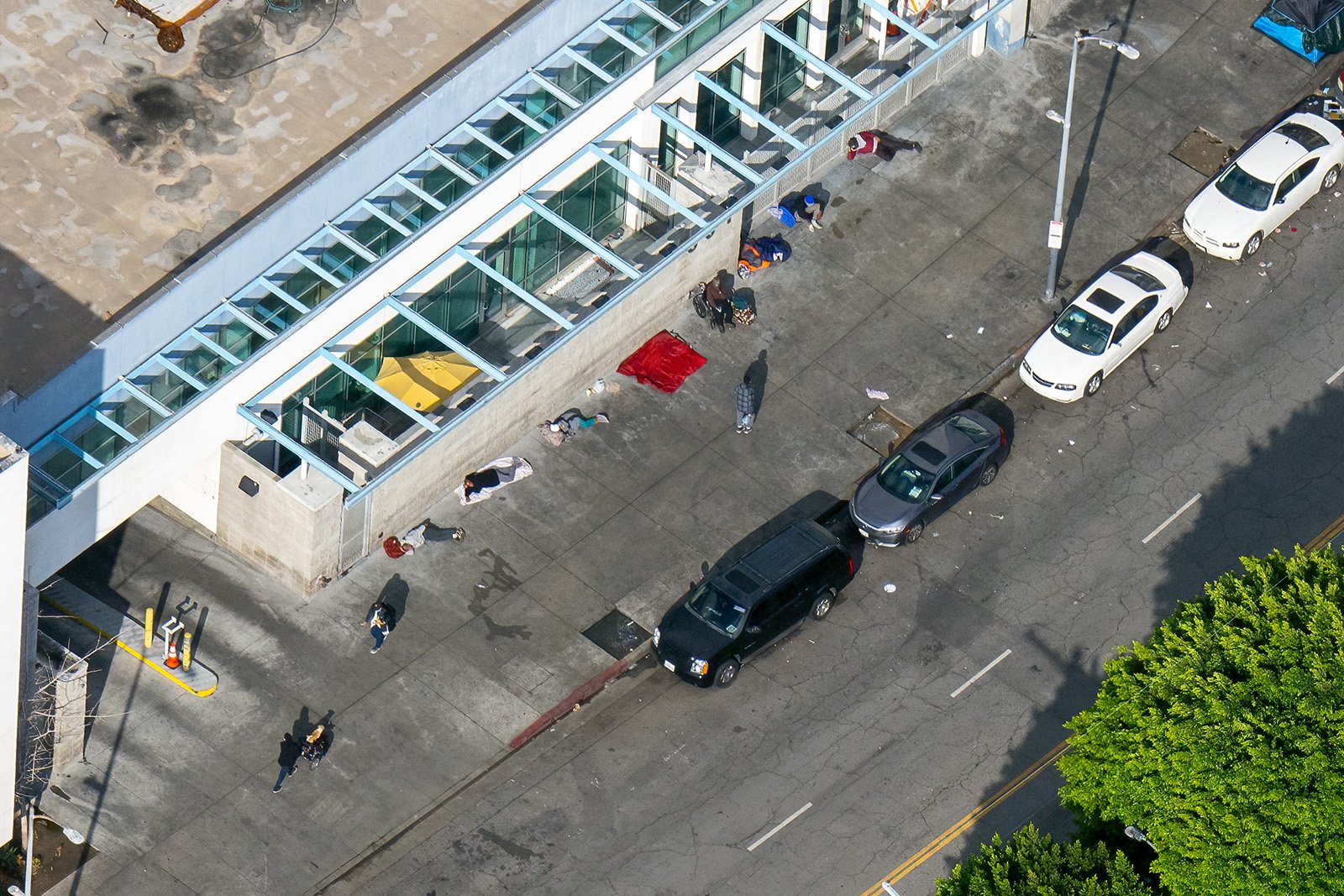
Homelessness is one of the most pressing issues in the country today, and Los Angeles is the epicenter of a housing epidemic that has been decades in the making. The homeless population in LA has risen drastically over the last few years and according to the latest count, there are now 69,144 people living on the streets of Los Angeles County — an increase of over 25 percent from 2018, despite a sustained increase in the number of people being rehoused.
Through aerial photographs, we can glimpse what life is like for those experiencing homelessness and begin to further comprehend the state of homelessness in Los Angeles. We hope that by sharing these photographs we can bring awareness to this pressing issue and help create positive change.
Being Homeless in Los Angeles
Homelessness is an epidemic that affects all walks of life, from veterans to children to individuals struggling with serious mental illness or addiction. The problem has become so widespread that it can now be seen in public spaces throughout the city. But the true extent of homelessness remains largely hidden from view.
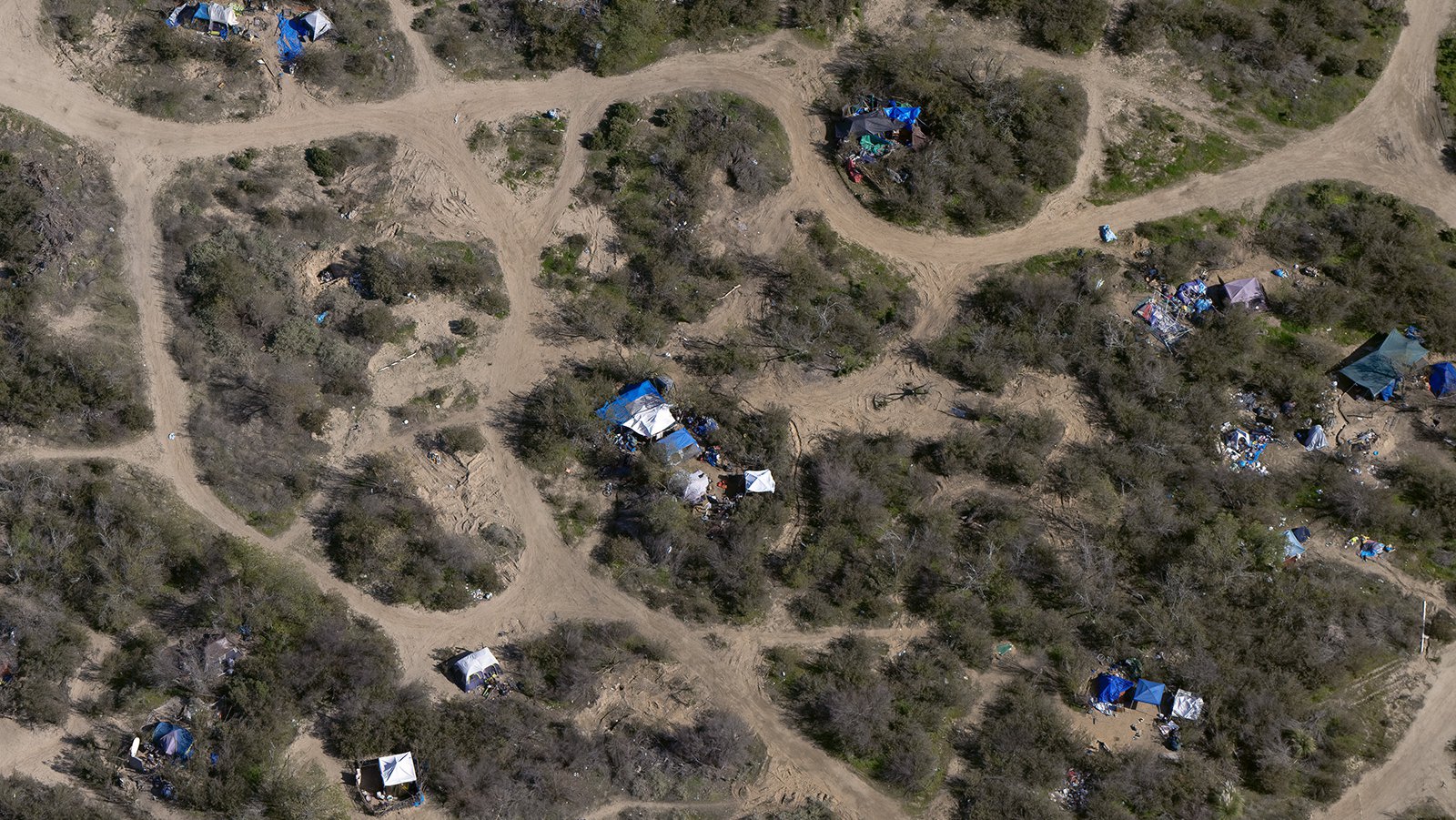
An aerial photo of a park reveals small, clandestine homeless tents tucked away in the secluded open space, providing temporary shelter for those who are unable to find stable housing.
The first step towards creating solutions is understanding the problem, and through aerial photos we can gain a more comprehensive view of homelessness in Los Angeles.
The Scale of the Homelessness Problem
According to data from the 2022 LAHSA Homeless Count, there are more than 69,000 homeless people living in LA County—an increase of over 25% from 2018—almost half of the total California homeless population (source). This number includes people struggling with severe mental illness and addiction, veterans, unaccompanied children, as well as individuals and families who's only crime is being victims of a shortage of affordable, permanent housing. On any given night, tens of thousands of Los Angelenos are sleeping unsheltered on the streets or in shelters across LA County. The City of Los Angeles alone accounts for over 41,000 homeless residents.
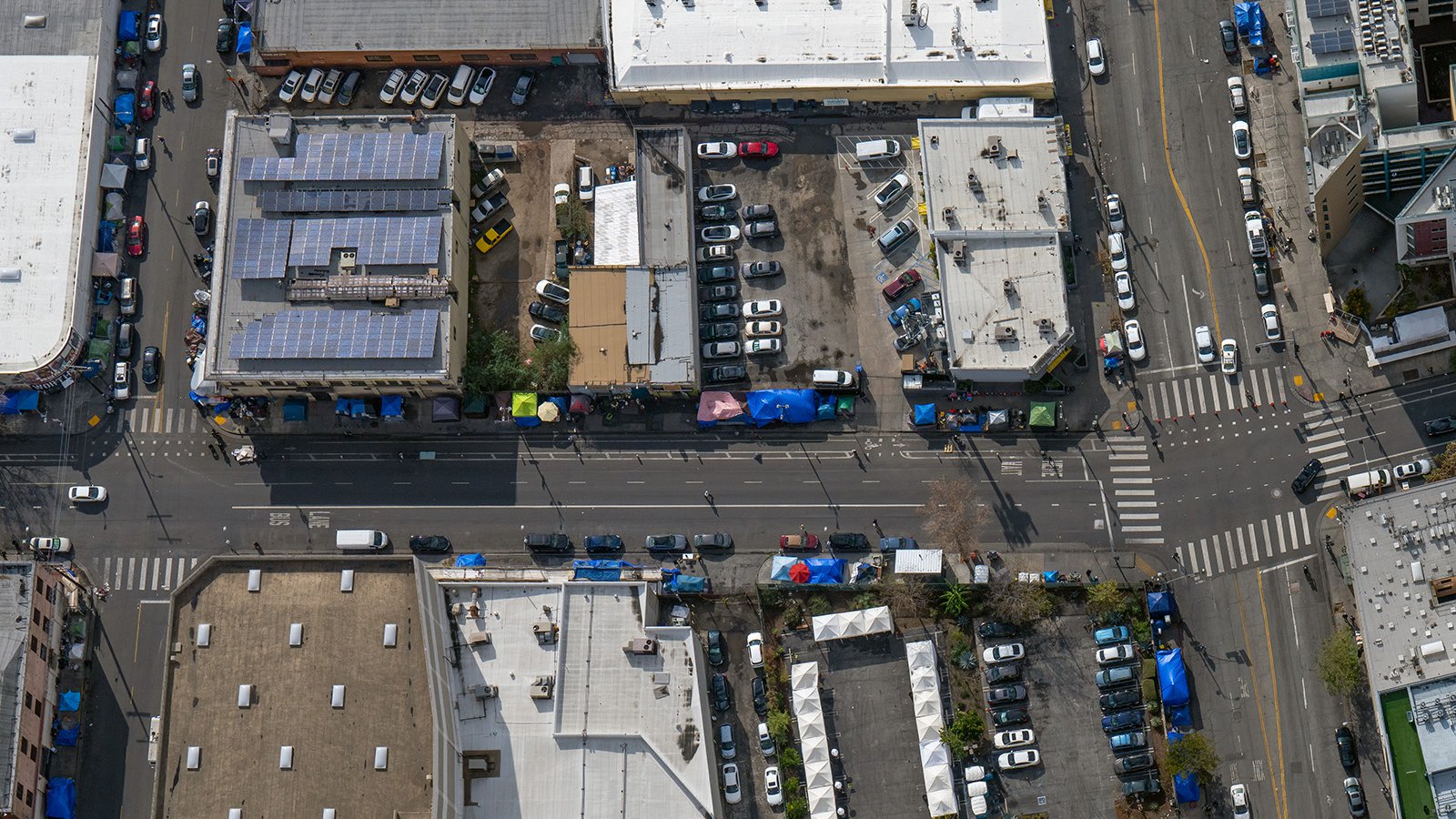
Aerial photo of Downtown Los Angeles revealing a startling scene: dozens of blue tents line the sidewalks, each one filled with homeless individuals struggling to survive in a city facing an immense homelessness crisis.
The Causes of Homelessness in Los Angeles
There is no single cause of homelessness, but poverty and lack of more affordable housing are two major contributing factors. A recent study found that there is an estimated shortage of 499,000 affordable housing units in Los Angeles County (source) — meaning that many low-income families or individuals simply cannot find an affordable place to live. Additionally, rising rents have pushed even more out onto the streets, many of whom are unable to pay the high prices.
Wages have not kept pace with the rising cost of living, nor have payments for those on limited or fixed incomes, making it increasingly difficult for many to just make ends meet. Despite the Golden State's efforts and pandemic programs, increased cuts to federal government assistance programs and widespread inadequate mental health services have further exacerbated the situation.
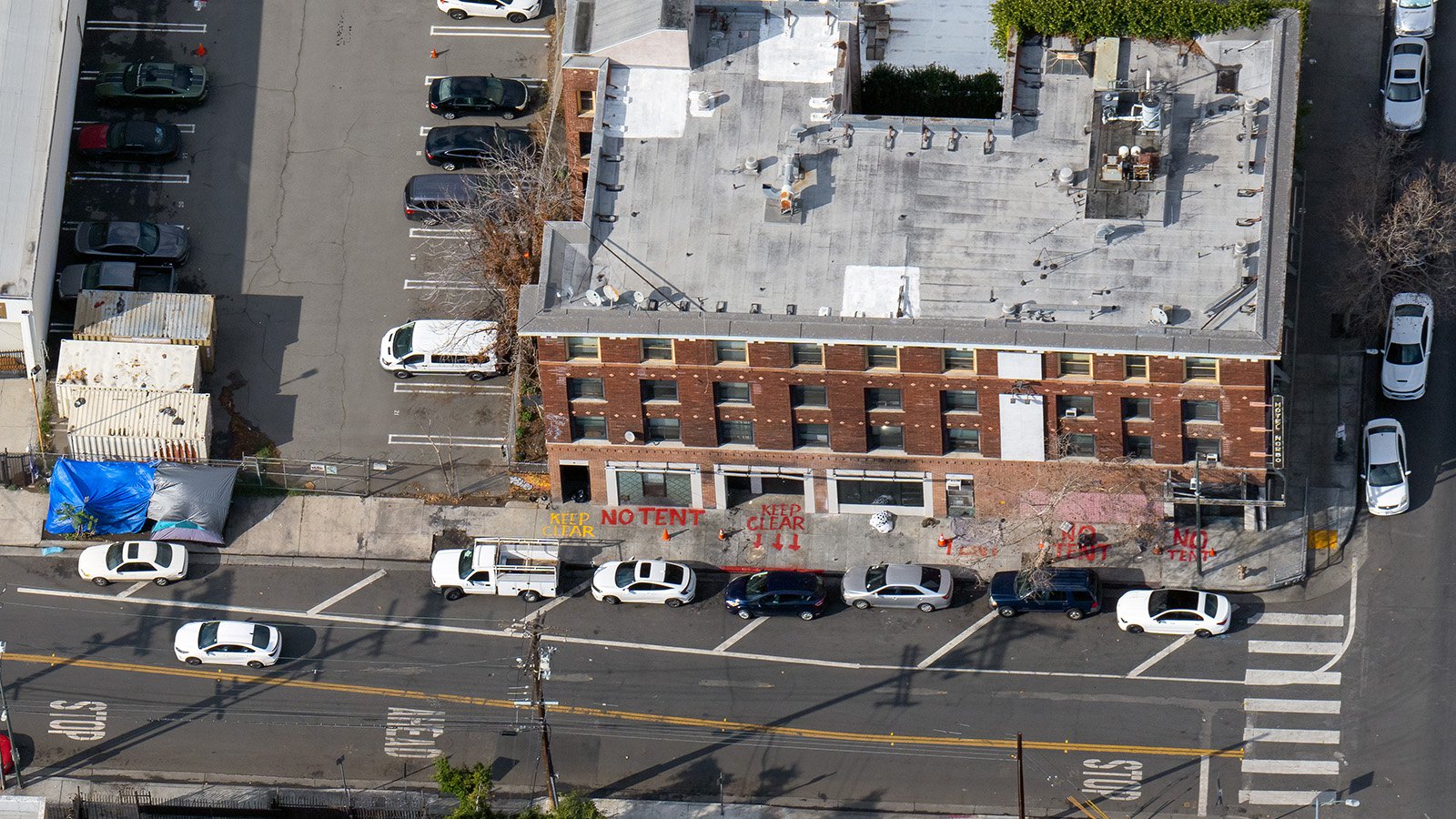
The sidewalk in front of a Downtown low-income housing building displays a message of "no tents" and "keep clear" boldly painted just outside the entrance, demonstrating an unwelcoming attitude towards homeless individuals by those lucky enough to have permanent housing.
The Impact on Local Communities
The homelessness crisis is having a devastating impact on local communities throughout LA County. Studies have shown that areas with higher concentrations of homeless people experience more crime, drug use, and mental health issues than those with lower concentrations. Homeless encampments also create environmental hazards such as overflowing trash bins and human waste buildup which can lead to serious health concerns for residents living nearby.
What Has Been Done?
Local leaders along with city, county, and state governments have taken various steps to combat homelessness by providing funding for temporary shelters (like Project Roomkey), increasing access to mental health services, and developing new interim housing opportunities for those in need. However, these initiatives have had limited success so far. To truly make an impact on this crisis and end homelessness, elected officials must make long-term investments into permanent supportive housing solutions which provide stable homes and services for those experiencing homelessness.
There is no one-size-fits-all solution for solving homelessness; instead it will require a multi-faceted, comprehensive approach that addresses both short-term needs as well as long-term strategies for prevention and sustainability. Short-term relief could come in the form of increased access to shelter beds and supportive housing units (like tiny home villages); emergency rental assistance programs; and initiatives to provide meals and other basic necessities for those experiencing homelessness. Longer-term solutions could include increasing funding for mental health services; expanding access to affordable, permanent housing; and creating pathways out of poverty through education initiatives like job training programs.
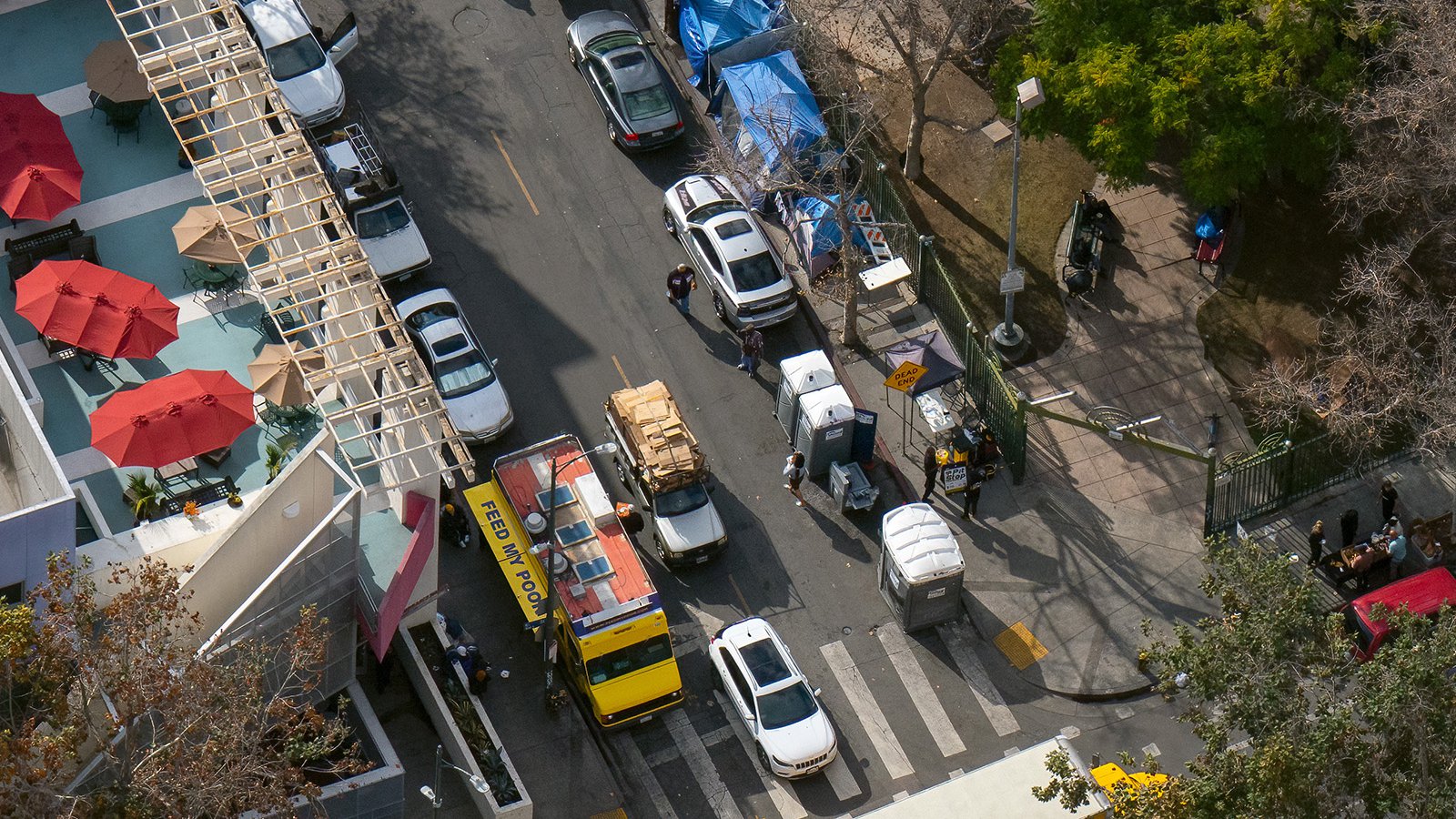
Aerial image of a food truck by Feed My Poor, which provides nutritious meals to those in need. A striking contrast between the homeless under blue tarps across the street from the upscale building rooftop, highlighting the growing inequality in Los Angeles.
What Can I Do to Help?
There are several ways that individuals can help those who are affected by chronic homelessness. One way is by donating money or supplies, such as food and clothing, to homeless shelters and other charitable organizations that serve those experiencing homelessness in LA County. Another way is by volunteering time or offering one-on-one assistance, such as helping someone find job opportunities or temporary housing options. Ultimately, advocating for policy changes, such as increasing funding for mental health services and expanding access to affordable housing, is essential if we want to see long-term improvements.
Policy Solutions to Combat the the Growing Homelessness Crisis
In order to create lasting solutions, it is essential to explore potential strategies that will help unhoused people and prevent the homelessness problem from worsening.
One potential solution is to increase access to affordable, permanent housing. Los Angeles has among the highest rental prices in the nation, making it increasingly difficult for people to find stable and safe housing. Low-income housing options or rental assistance programs could help reduce the cost of living and make it easier for homeless people to find more affordable housing.
Additionally, providing resources for mental health and substance abuse treatment will be vital to finding a long-term solution. Many homeless individuals are unable to access needed services due to a lack of resources and funding. By investing in mental health services, we can help those with existing conditions receive the help they need, preventing more people from becoming and remaining homeless due to addiction or mental illness.
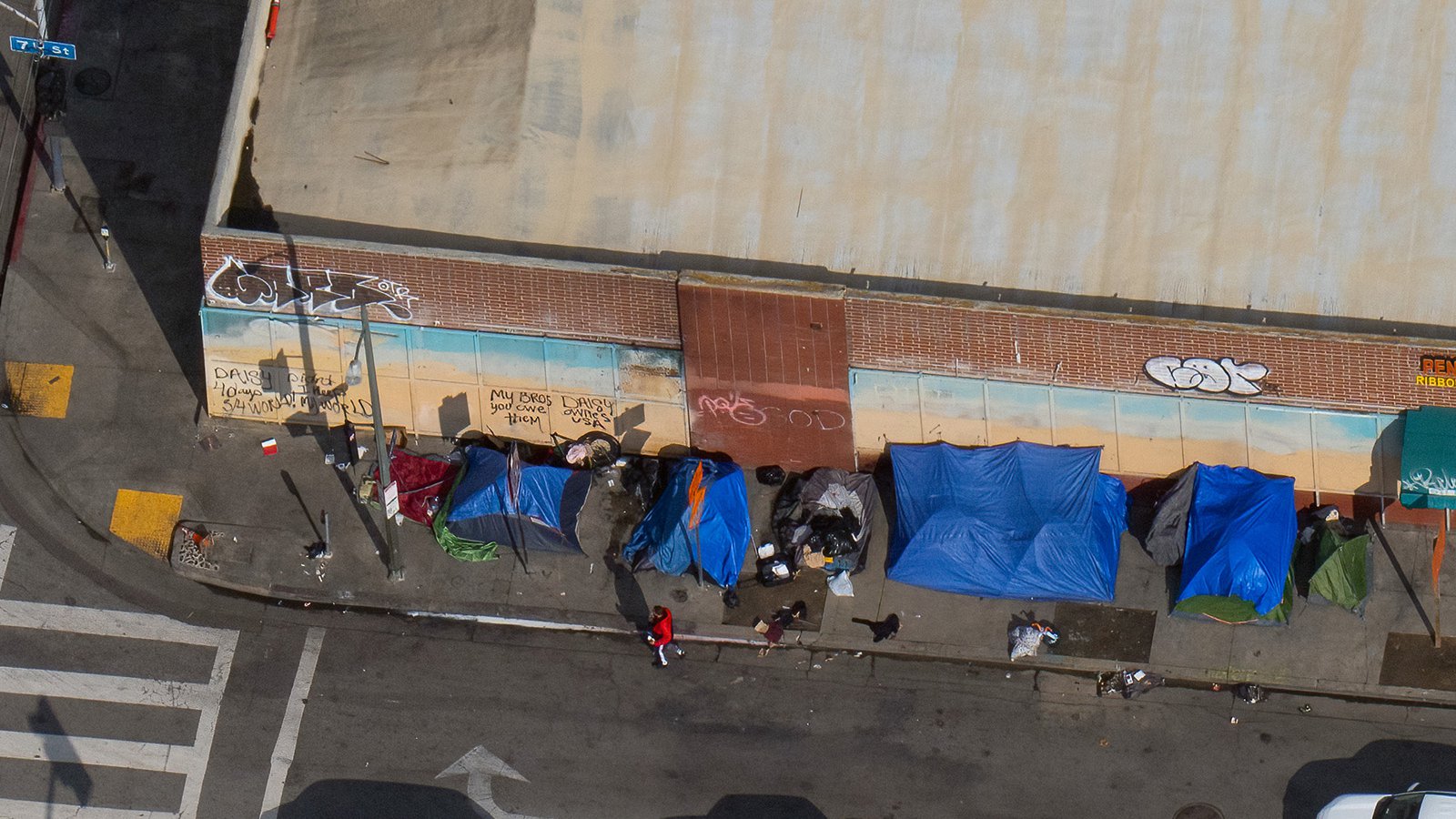
Several homeless individuals living on the sidewalk with tents and signature blue tarps, their belongings strewn around them, while graffiti messages on the wall draws attention to the impact mental illness has on the homelessness crisis.
It is important to provide long-term solutions rather than short-term fixes. While temporary shelters are needed during spikes in homelessness, we need to focus on creating sustainable programs, like tiny home villages, which are able to provide services that will help chronically homeless individuals become permanently housed.
Tiny Home Villages
It has become necessary to explore innovative solutions for homelessness, like tiny home villages. Interspersed throughout the city on city-owned land, these unique developments offer critically important insulation from both the physical and emotional elements faced by those living on the streets. These villages provide an immediate safe haven for those without access to conventional housing, including offering residents resources and support from experienced social workers, in order to ultimately enable residents to transition into permanent housing and self-sufficiency. As homelessness continues to be an issue across the country, it's encouraging to see that major cities like Los Angeles are working on finding novel solutions like tiny home villages.
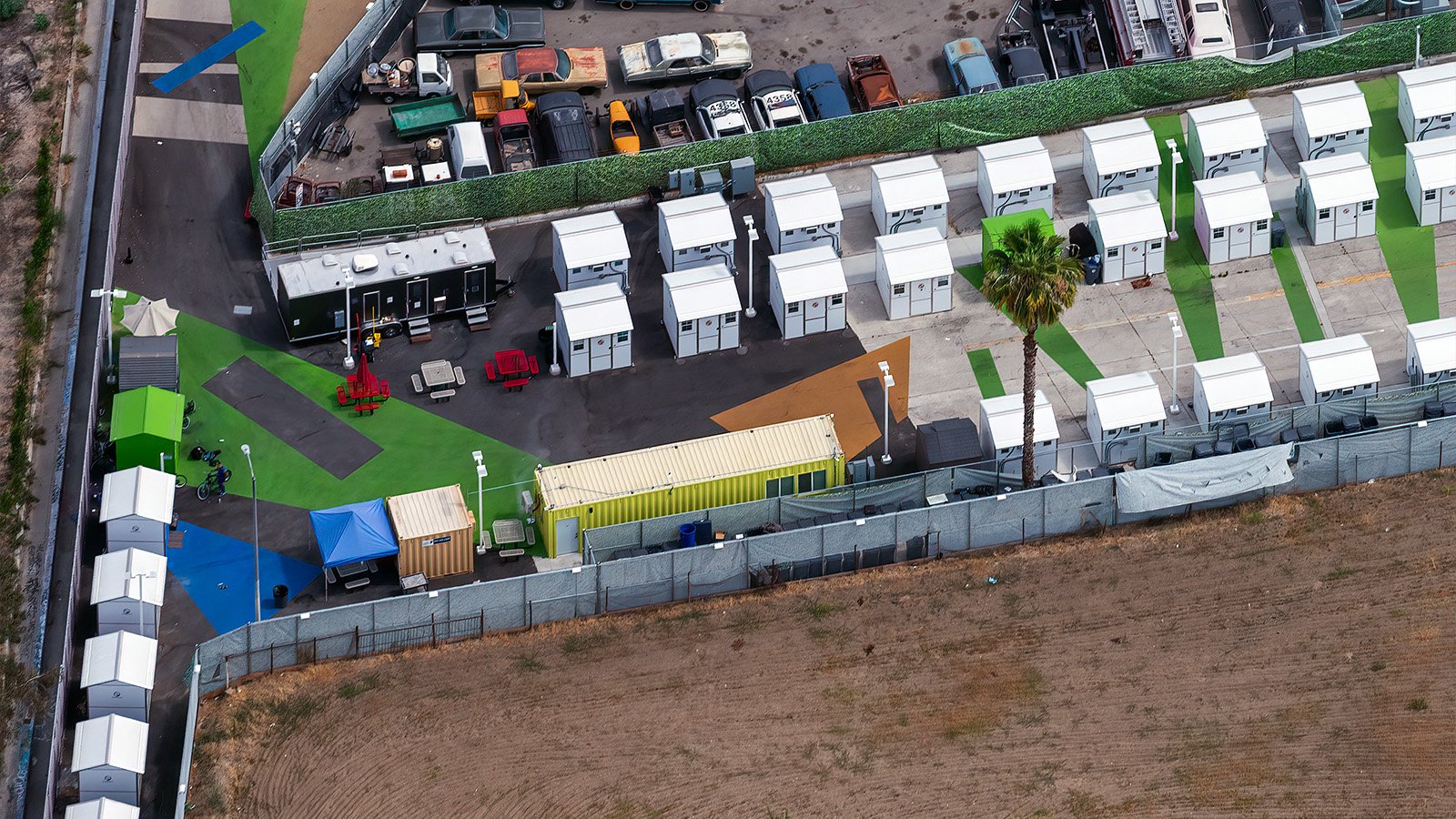
Located off the 170 freeway and consisting of 77 units and 150 beds, the Whitsett West Tiny Home Village is able to provide interim housing for nearly 600+ unhoused Angelenos annually, allowing them their first steps off the streets and into permanent housing.
Hope of the Valley
Organizations such as Hope of the Valley are stepping up to combat homelessness and provide their Los Angeles community with hope for change. One way that they are achieving this is by working to create tiny homes for those experiencing homelessness. By providing a safe and secure place for individuals to sleep every night, these tiny home villages give residents a chance to get back on their feet and eventually find more permanent housing. Not only do these tiny home villages reduce overall street homelessness, but they also provide supportive communities for those living within them. They are designed to help people transition from homelessness into more stable housing, while offering life skills workshops and health services to assist people back on their feet.
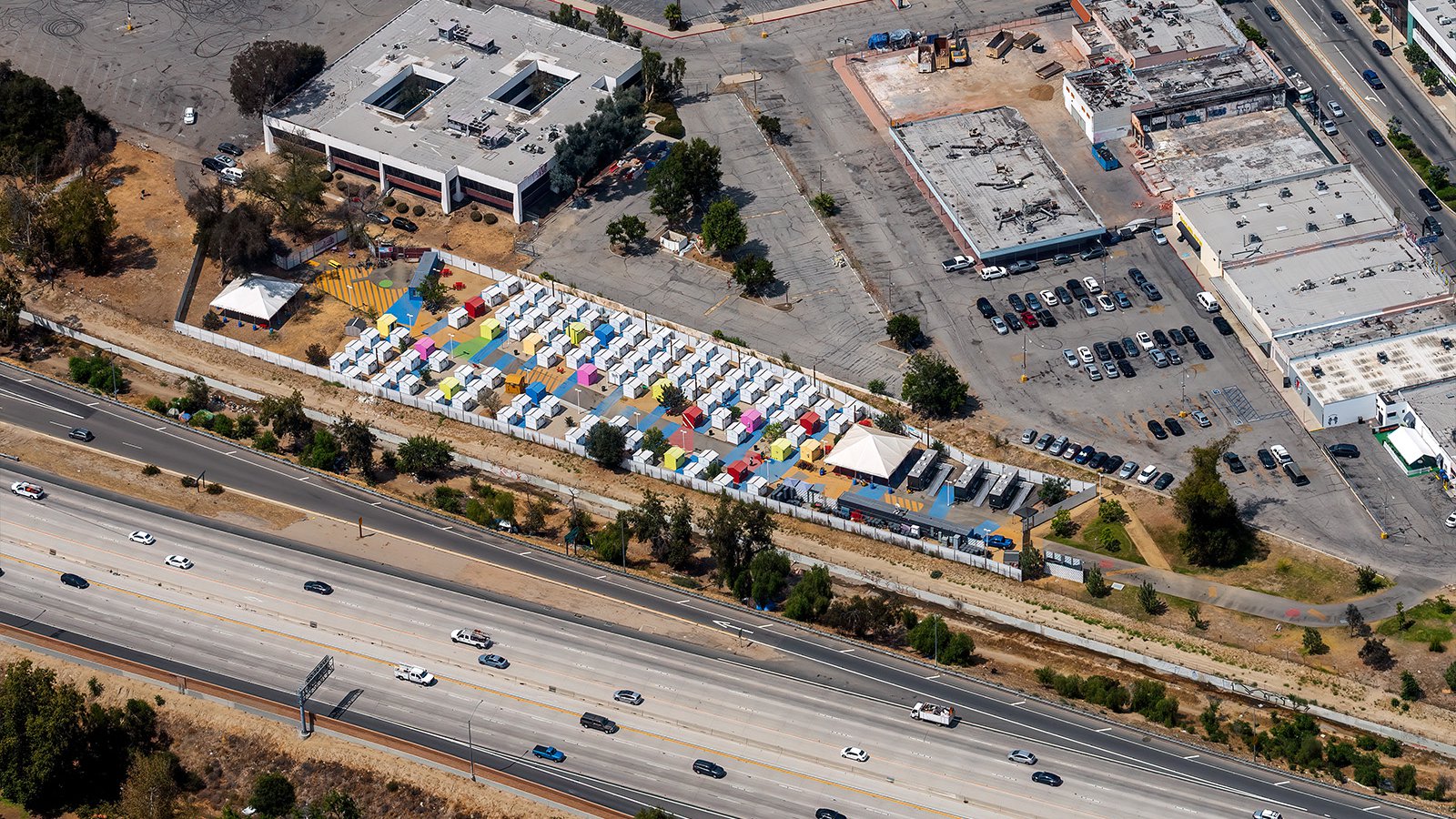
Alexandria Park Tiny Home Village in North Hollywood, California showcases a unique collection of colorful tiny homes on city-owned land alongside the freeway, providing an innovative living solution to the city's homelessness crisis.
River Haven - Turning Point Foundation
River Haven Community in Ventura, California offers an invaluable service to the homeless population just outside of Los Angeles County. Located on a 2.7-acre lot, the community provides a safe haven for the unhoused or those at risk of homelessness. Operating under a housing-first model—which includes an array of services like mental health care, substance abuse counseling, basic needs resources, and job readiness training programs—River Haven ensures that those who call it home have the opportunity to transition towards more permanent housing. The organization offers further services such as legal assistance, application help, and overall case management to ensure that residents have a high opportunity for success.

Aerial photo of River Haven in Ventura, California, offering a housing-first model with a variety of supportive services to help transition residents towards permanent housing.
A Unique Perspective on the Homeless Crisis
Aerial photography provides a unique perspective on homelessness that cannot be seen from the ground. Using aerial photographs, viewers can get a greater sense of the scale of the problem and how it has impacted different parts of the city differently.
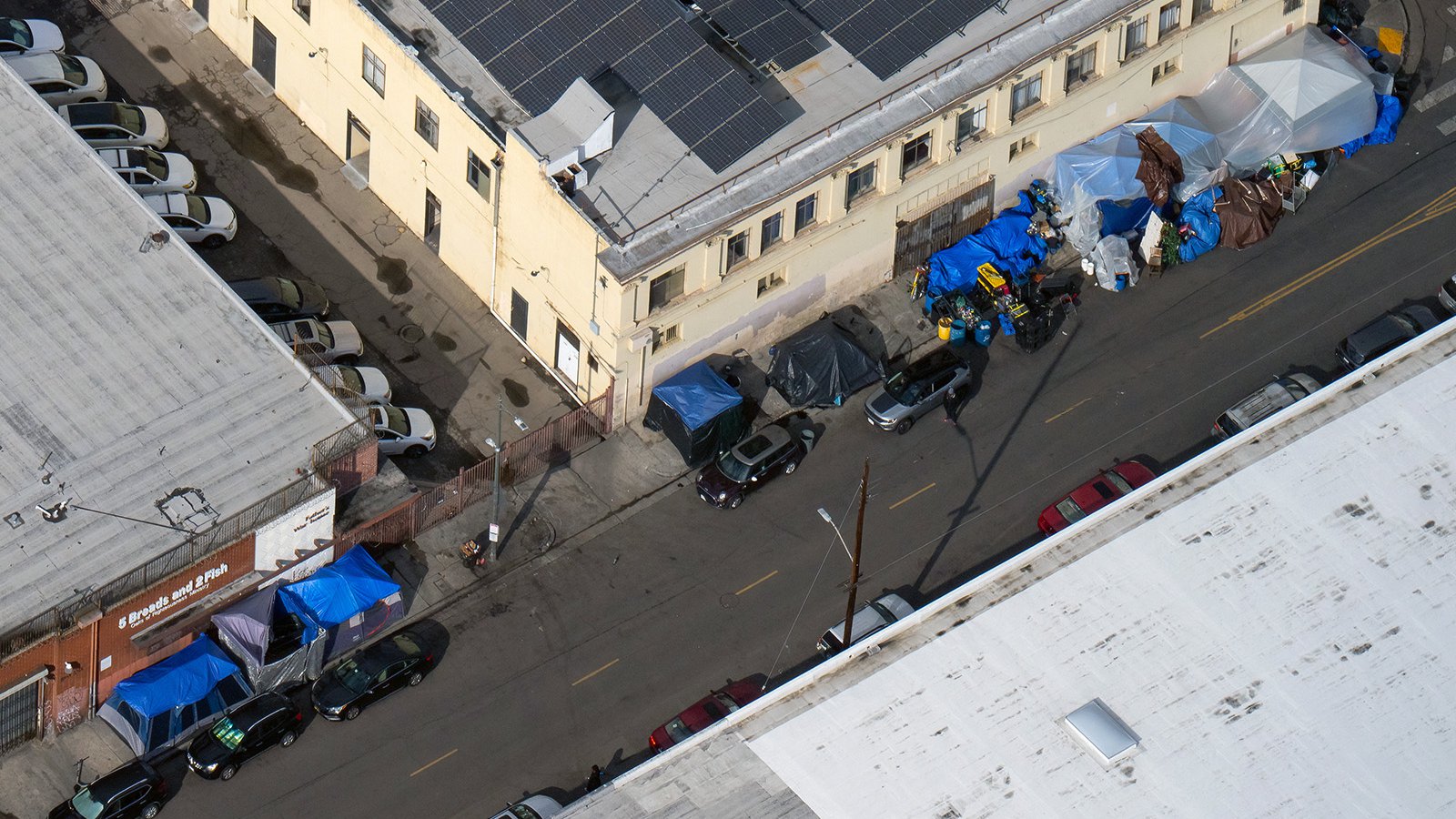
An aerial photograph of unhoused people living on the sidewalk outside 5 Breads and 2 Fish, a ministry providing aid and resources for those in need, revealing the unfortunate reality of homelessness in our society and the need for such organizations that offer hope to those with nowhere else to turn.
By looking at these images from the above, we can gain a greater appreciation for how difficult it is to survive without a home and see firsthand just how many people are suffering on the streets of Los Angeles each day. Aerial photography allows us to gain an understanding of homelessness in Los Angeles that no other medium can provide.
Aerial photos provide an unprecedented view of homelessness in Los Angeles, revealing the makeshift dwellings and camps that have sprung up around the city. From this unique perspective, we can see how large and widespread the problem of homelessness has become in Los Angeles, with camps stretching throughout downtown and into neighboring counties.
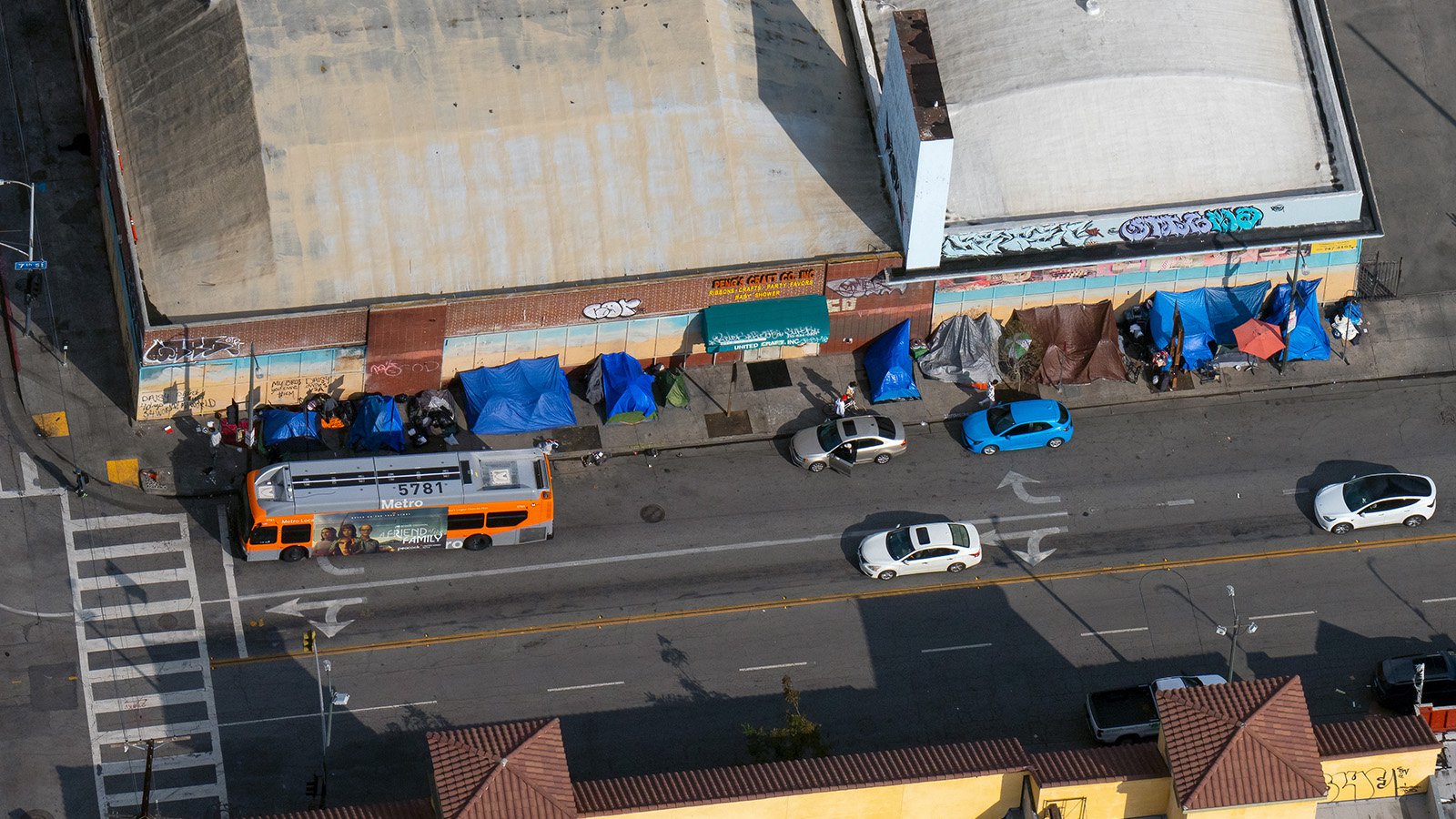
An aerial photo of downtown Los Angeles showing sidewalks blanketed with blue and brown tarps, demonstrating the massive scale of homelessness in LA and highlighting the need for effective solutions.
The homelessness crisis in Los Angeles is a complex and urgent issue that requires immediate attention. By looking at aerial photos of homeless camps throughout the city, we can gain insight into this problem and understand more about the reality of life for those experiencing homelessness. To address this growing problem, we must increase access to affordable housing, provide mental health services for those without homes, and focus on long-term solutions rather than short-term fixes. Additionally, readers can help by donating money or time to local organizations serving the homeless population or advocating for policy reform in their community. With collaboration from all sides working together towards lasting change, we have hope that one day there will be an end to homelessness in our great city of Los Angeles.
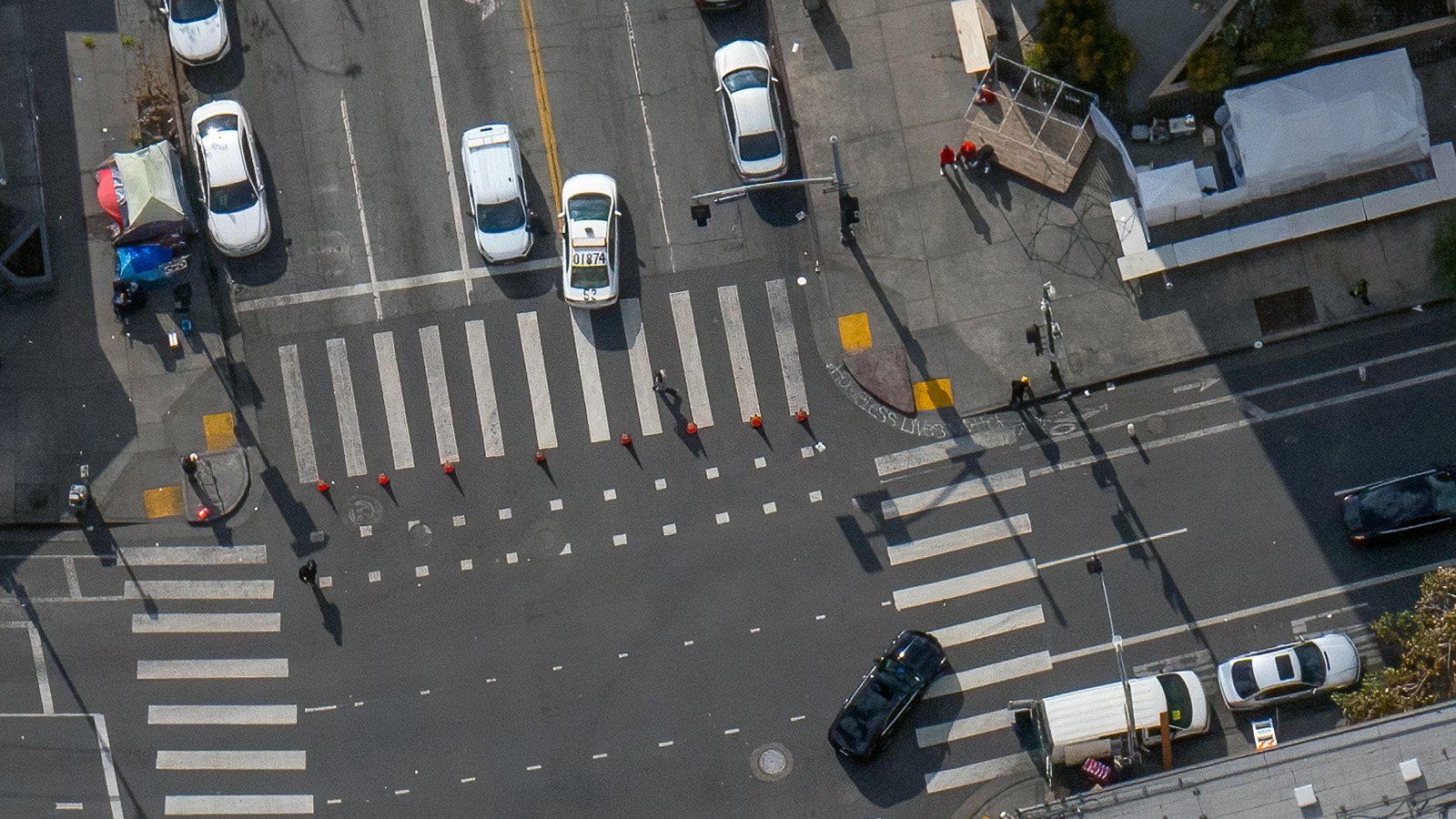
An aerial photo of street graffiti message in Downtown Los Angeles reading "Homeless Lives Matter", an homage to the Black Lives Matter movement, drawing attention to the struggle for homeless rights and protection.